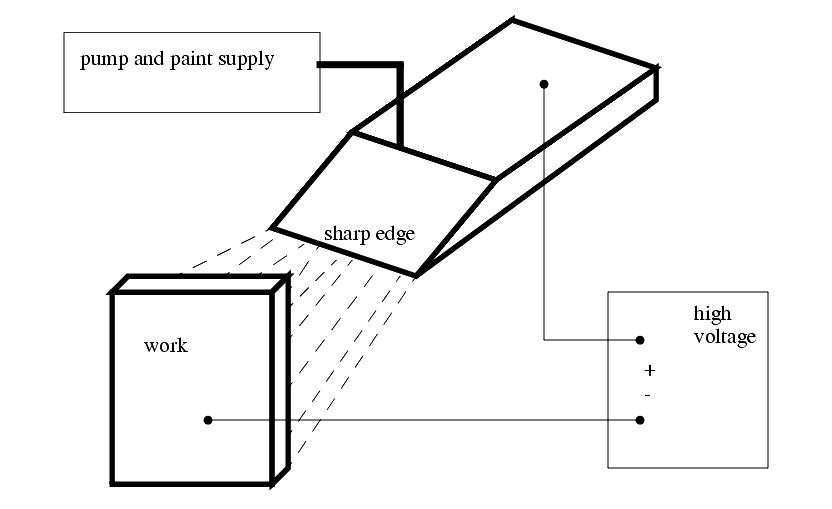63.1 ELECTROSTATIC ATOMIZATION METHOD
������������
The Blade Method 9Ransburg's No. 1 process),
- a straight sharp edge is used charged to about 90 KV
- the paint is slowly pumped onto the blade, it spreads out, and by the time it reaches the tip it comes off as small charged droplets.
- the shape of the workhead encourages a linear dispersion pattern
- high efficiency/low wastage
- suited to flat surfaces
- limited dispersion patterns
- least cost effective and flexible
The Bell Method (Ransburg's No. 2 process)
- uses a rotating bell or funnel to disperse the paint
- the bell head is about 1 ft. from the workpiece
- a potential of 90-100 KV is applied to the head while the work is grounded
- the head rotates at 900 r.p.m. to cause good paint dispersion
- good coverage for rounded surfaces
- better efficiency than blade method
- suited to spherical irregular shapes
- extra power/equipment to run motor
ASIDE: the edge effect in electrostatic phenomenon leads to higher concentration of charges at corners and edges.
The Disk Method (also Ransburg's No. 2 process)
- similar to Bell method except that a flat disk is used.
- the geometry of the disk allows a much wider spray coverage
- advantages (compared to bell),
- well suited to irregular and long parts
Rotating Bell handgun
- can be used for manual/movable spraying
- is well insulated to prevent shocks
- well suited to complex shape because of operator aiming
- most effecient and cost effective method
Consider the comparative tables [source unknown],
Air/Hydraulic Electrostatic Spraying
- large negatively charged (100KV) electrodes are placed at the side of a spray paint line
- work on the central conveyor is rounded,and uncharged paint is sprayed in.
- the sprayed paint enters the electic field, becomes negatively charged and is drawn to the work.
- can be upgraded to a full electrostatic method easily
- a higher paint wastage results.
- a typical spray gun head is modified to deposit a high voltage charge on the paint particles
- the paint is sprayed with a negative charge, and it is attracted to a grounded workpiece
- the paint is charged before passing through the spray head
Control systems (power supplies) for spraying a resistive/non-resistive. Resistive systems use resistors to limit the maximum current that can be drawn, thus protecting the users. Non-resistive sysems require added safety precautions and are best suited to automate systems.
The edge phenomenon can result in uneven distribution of paint near edges and corners.
The Faraday cage effect will result in recessed areas that get less paint coverage.
Safety issues include electrical shocks, ventillation (most paints are solvent based), and arcs from poor grounding or unexpected metal contact.
Some automation issues are,
- part recognition on a conveyor
- booths are costly, but provide safety and process advantages




